The 20 Best OTT Platforms for Building Your Own Streaming Service Going Into 2025
The way we consume entertainment content, particularly video, has changed drastically over the last decade. The number of people turning to the internet for news, livestreaming, entertainment, education, and more has skyrocketed. The OTT platforms market is powered by over-the-top (OTT) video technology. The OTT video services market is consistently rising, predicted to be worth $247 billion by 2027.
Businesses are hopping on this trend by creating online video companies to build brand awareness and provide value to their audience. That, in turn, fuels the growing demand for more OTT providers and channels that can reliably and securely host over-the-top streams.
Many companies seize this opportunity to monetize their video content and build top-quality OTT broadcasting services and platforms.
Picking the right OTT channel for your organization’s needs from all the choices available today is quite a task. Today, we’re going to discuss precisely what an OTT platform and over-the-top streaming are before we compare 20 of the best online OTT streaming platform services that viewers use to access their favorite video content.
Then, we will compare over the top 20 best OTT platforms broadcasters use to host, manage, and monetize their over-the-top online video libraries. We’ll cover some of the top OTT video platforms, including Dacast, IBM Cloud Video, JW Player, Vimeo OTT platform, Wowza, and more.
Please note that OTT platform technology and pricing change regularly, and this post now reflects the most accurate information as of April 2025.
Table of Contents:
- What is an OTT Streaming Service?
- State of the Over The Top Market
- The OTT Streaming Industry at a Glance
- Why Trust Dacast’s OTT Reviews?
- The 10 Most Popular OTT Streaming Services
- What is an OTT Platform?
- Comparison of the 20 Best OTT Platforms Going Into 2025
- Why do Businesses Launch Their Own OTT Platforms?
- OTT Aggregators and Attribution
- How to Choose an OTT Platform
- FAQs
- Conclusion
What is an OTT Streaming Service?

An over-the-top (OTT) streaming service helps content creators bring their content to viewers via the Internet.
OTT is short for “over-the-top,” This media distribution method serves as an alternative to traditional satellite or cable television.
Over-the-top technology is distributing more and more media each day. In fact, it has redefined our media distribution channels to the extent that most media is not delivered to consumers via the internet. Some industry leaders even advocate that we stop differentiating between OTT vs CTV, streaming, broadcasting, and cable TV content, entirely.
OTT streaming services are apps or websites viewers use to access their favorite programs and movies. These services are accessible on all internet-enabled devices, including smart TVs, gaming consoles, computers, laptops, smartphones, and tablets.
Content availability on OTT platforms is limited to paying viewers using one of these OTT monetization models:
- TVOD: Viewers pay for access on a pay-per-view basis. They can either rent or buy a particular video. Purchasing gives them lifetime access to it and renting usually lets you watch it for a specific period.
- SVOD: Viewers are granted unlimited on-demand access to the platform on a subscription basis. They get access to the content based on their plan and its duration. Usually subscriptions are monthly or annual.
- AVOD: Online broadcasters monetize their content with sponsored advertisements. Advertisers will pay a fee for every ad rendered in the video. There are platforms that are set up to automate the transactions between content creators and advertisers, so you don’t typically have to seek out or negotiate deals with the advertisers.
State of the Over The Top Market
The Over-The-Top (OTT) media market has experienced remarkable growth in recent years. In 2024, the global OTT market was valued at approximately $575.8 billion and is projected to reach around $3,741.9 billion by 2033, reflecting a compound annual growth rate (CAGR) of 22.9% during this period. This surge is driven by increasing internet penetration, the proliferation of smart devices, and a consumer shift towards on-demand, personalized media services.
In the United States, OTT video revenue reached an estimated $288 billion in 2023, with the country accounting for the largest share of this revenue. This trend underscores the growing importance of OTT platforms in delivering video content, as consumers continue to move away from traditional broadcasting methods.
The Asia-Pacific region is also witnessing significant growth in the OTT sector, driven by the increasing adoption of smartphones and affordable internet services. This expansion presents substantial opportunities for businesses aiming to enter or expand within the OTT market.
Overall, the OTT market’s rapid expansion offers lucrative prospects for content creators, service providers, and technology developers aiming to capitalize on the evolving digital media landscape.
The OTT Streaming Industry at a Glance
OTT streaming platforms are more popular than ever since they put more control in the hands of both viewers and broadcasters. Thanks to OTT platform technology, both the creators and consumers are free from the regulations and restrictions of television networks.
Here’s a snapshot of some of the top trends in over-the-top online streaming:
- Streaming on smart TVs and CTVs is on the rise as more viewers cut the cable cord and opt for top online streaming companies
- The OTT marketing companies industry is forecasted to be worth $1.039 trillion by 2027
- As of June 2024, there were about 3.9 billion OTT video users worldwide.
- In the United States, OTT viewership is expected to reach over 250 million in 2024, which is nearly 75% of the US population.
- As more OTT platforms enter the market, UX is more important than ever
- Over half of OTT revenue comes from advertisements
- Nearly a third of OTT subscriptions in the United States go to Netflix
- Live streaming only accounts for 24% of over-the-top streaming around the world
Check out our dedicated OTT trends post to learn more about this industry’s direction.
Why Trust Dacast’s OTT Reviews?
With over 15 years of experience powering professional OTT and VOD streaming for broadcasters, enterprises, and 400K+ content creators worldwide, Dacast is a trusted leader in over-the-top video. Our all-in-one OTT platform has supported thousands of successful streams across industries—from media and entertainment to education and sports. We know what makes a streaming platform reliable, scalable, and user-friendly. That’s why you can count on our recommendations to help you choose the right solution for your OTT streaming goals.
The 10 Most Popular OTT Streaming Services
Many OTT video streaming solutions are niche-specific, while others have broader offerings and are geared toward a more general audience. Some are OTT live-streaming services, while others offer on-demand free OTT services and content, premium content, or a mix of both.
Let’s look at some of the most popular ones and make some OTT service comparisons.
1. Netflix
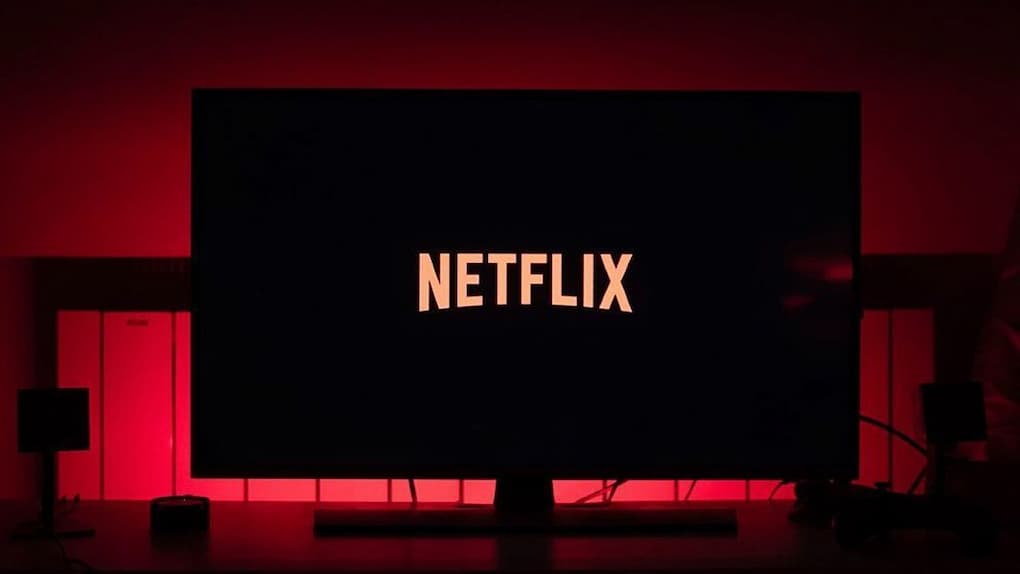

Netflix is one of the original OTT streaming servicesIt started as an online DVD rental shop. Its quick adaptation as live streaming technology began to surface is part of its success.
Today, Netflix is one of the largest on-demand streaming platforms on the internet, featuring over 15,000 titles. Unlike Apple TV, Netflix features titles from other production companies, and original content is only available on its platform.
Revenue:
Revenues are projected to grow at about 15% in 2024 to almost $39 billion
Pricing:
Netflix offers three different monthly pricing plans that include unlimited, ad-free streaming. However, the online streaming company recently launched an ad-supported pricing tier as well. Their pricing plans include 3 tiers:
- Standard with ads*: $6.99 / month
- Standard: $15.49 / month (extra member slots** can be added for $7.99 each / month)
- Premium: $22.99 / month (extra member slots can be added for $7.99 each / month)
2. Apple TV+


Apple TV+ is an OTT streaming service from iPhone maker Apple. One unique aspect of is that it features exclusive Apple Original shows and movies from some of the industry’s top talent. Apple TV+ is available on Apple devices, smart TVs, consoles, and sticks, and via OTT technology on tv.apple.com.
Revenue:
In fiscal year 2024, Apple’s Services revenue reached $96.17 billion, up from $85.2 billion in 2023
Pricing:
Apple TV+ costs $9.99/month, and is also included in Apple One, which bundles up to five other Apple services into a single monthly subscription.
3. Disney+
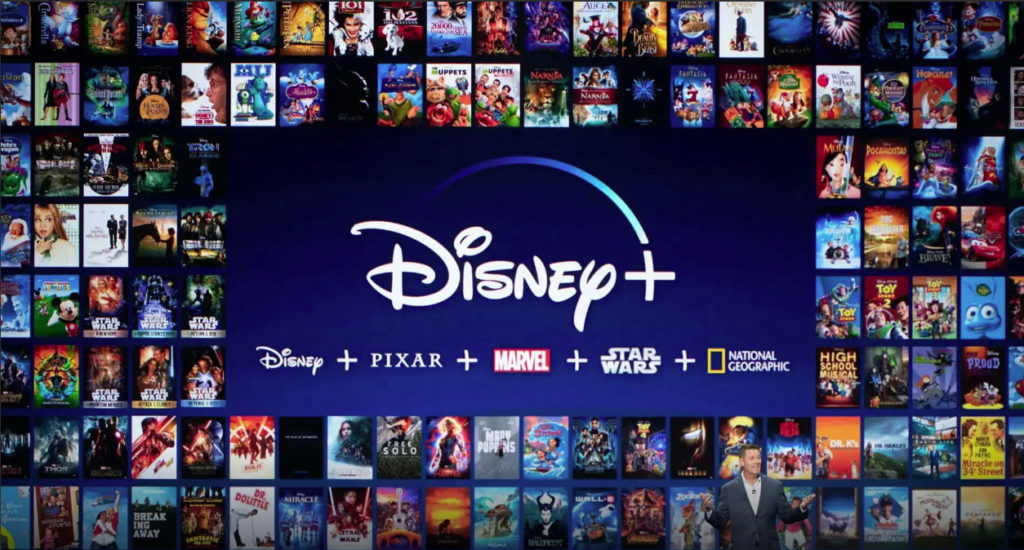

Disney+ is an over-the-top streaming service offering access to films and TV series owned by The Walt Disney Company. These include programs by Disney, Pixar, Marvel, Star, National Geographic, and Star Wars.
Revenue:
In fiscal year 2024, Disney+ generated approximately $8.4 billion in revenue.
Pricing:
Disney+ pricing plans include:
- Disney+ Basic (With Ads) – costs $9.99/month.
- Disney+ Premium (No Ads) – costs $15.99/month or $159.99/month for unlimited ad-free streaming.
- Disney Bundle Duo Basic (With Ads) – Disney+ can be bundled with Hulu for $10.99/month.
- Disney Bundle Duo Premium (No Ads) – the same Hulu bundle without ads costs $19.99/month
- Disney Bundle Trio Basic (With Ads) – Disney+ can be bundled with Hulu & ESPN+ for $16.99/month.
- Disney Bundle Trio Premium (No Ads) – the same Hulu & ESPN+ bundle without ads costs $26.99/month
- Disney Max Bundle (With Ads) – Disney+ can be bundled with Hulu & Max for $16.99/month.
- Disney Max Bundle (No Ads) – the same Hulu & Max bundle without ads costs $29.99/month
4. Hulu
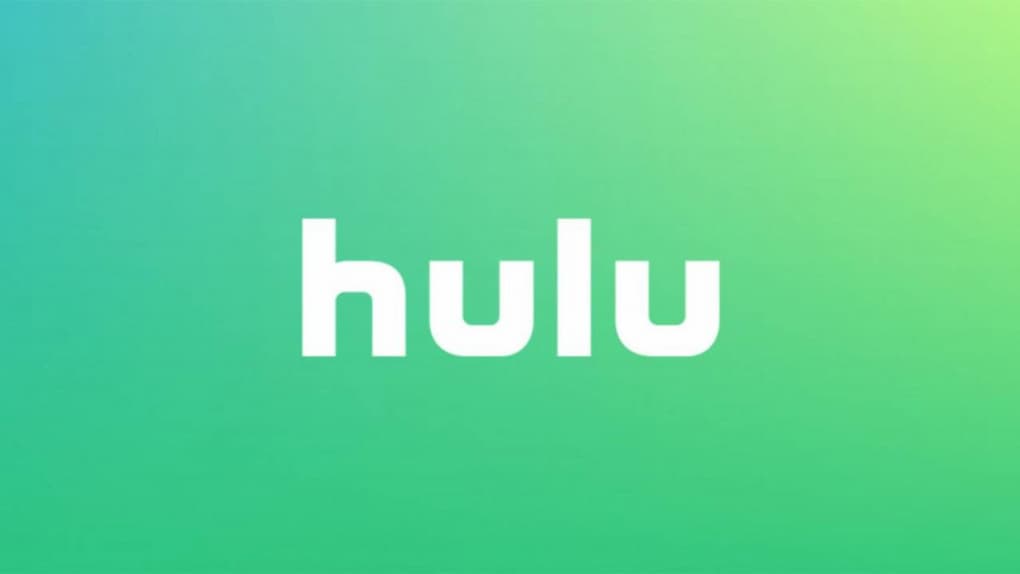

Hulu is another popular over-the-top video service. Hulu is different from Netflix, as new episodes are uploaded the day after they air.
Revenue:
As of the first quarter of fiscal year 2024, Hulu reported revenues of $2.95 billion, reflecting a 4.12% increase from the previous quarter’s $2.84 billion
Pricing:
Hulu offers six pricing plans, including
- Hulu: 9.99/month
- Hulu (No-Ads): $18.99/month
- Hulu (With Ads) + Live TV, Disney+ (With Ads) and ESPN+ (With Ads): $82.99/month
- Hulu (No Ads) + Live TV, Disney+ (No Ads) and ESPN+ (With Ads): $95.99/month
- Hulu (With Ads) + Live TV, Disney+ (No Ads) and ESPN+ (With Ads): $87.99/month
- Live TV only: $81.99/month
In addition to these plans, Hulu offers add-ons and bundled packages that give viewers access to other collections of content, as well.
5. ESPN+
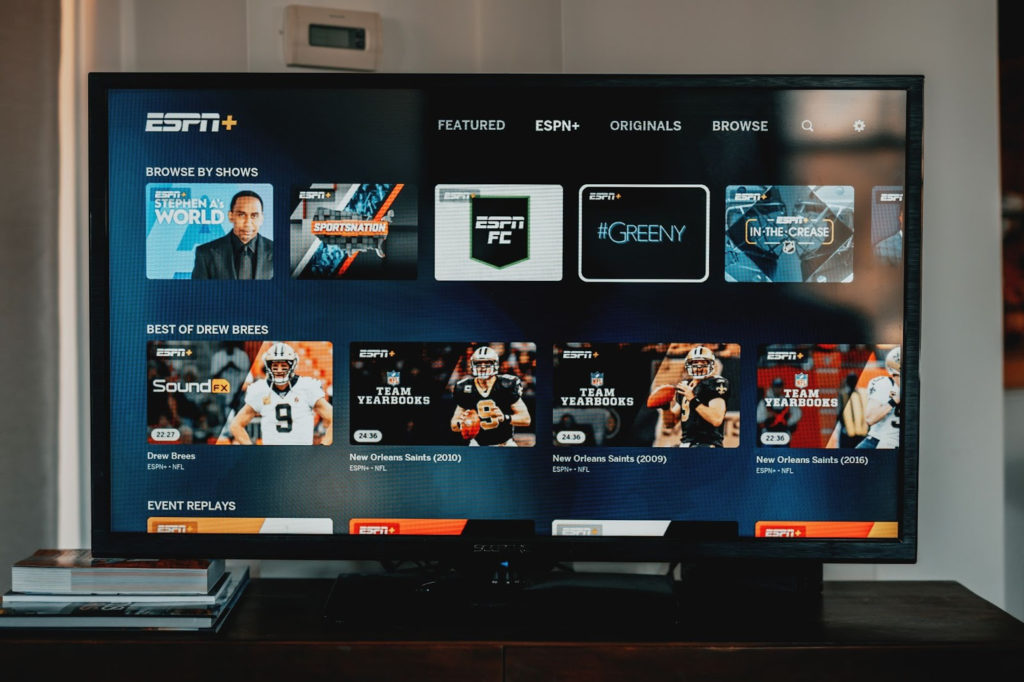

ESPN+ is an OTT service dedicated to sports streaming. This service differs slightly from the others we’ve covered because it focuses on live video streaming.
However, this broadcasting company also offers ESPN+ originals that are available on demand. The content, however, is all related to sports.
Revenue:
In fiscal year 2024, ESPN+ generated approximately $1.1 billion in subscription revenue.
Pricing:
ESPN+ offers the following plans:
- Basic ESPN+ subscription costs $11.99/month
- ESPN+ Annual Plan subscription costs $119.99/year
It can be purchased as part of a bundle with Disney+ and Hulu as mentioned in Hulu’s pricing above.
6. Prime Video


Amazon’s own service, Prime Video, offers unlimited access to a library of video content with a subscription, and it also has additional content available for rent or purchase.
One unique feature of this OTT video platform is that users can purchase access to films that are still in theaters. Prime Video also has access to live programming, like sporting events.
Revenue:
Amazon Prime Video’s revenue for 2024 is not publicly disclosed, but Amazon’s advertising revenue from the Prime Video’s ad-supported tier, is projected to reach $4.72 billion in 2024.
Pricing:
Prime Video is included in the Amazon Prime membership. However, certain movies might have to be purchased separately and aren’t included in your subscription.
7. HBO Max


An exciting aspect of HBO Max’s over-the-top service is that it offers access to movies that are still in theaters at no additional cost.
Revenue:
As of November 2024, specific revenue figures for HBO Max, but Warner Bros. Discovery, the parent company of Max, reported $7.7 billion in revenue from its direct-to-consumer segment in 2023, which includes Max.
Pricing:
HBO Max comes in three pricing tier plans:
- With Ads: $9.99/month or $99.99/year (16% savings)
- Ad-Free: $16.99/month or $169.99/year (16% savings)
- Ultimate Ad-Free: $20.99/month or $209.99/year (16% savings)
8. YouTube TV


YouTube is very unique in that it is a streaming service that hosts user-generated content (UGC). However, it also offers live TV via OTT technology. YouTube TV offers both subscriptions for unlimited streaming and pay-per-view for accessing individual pieces of content. YouTube TV offers live streaming access from over 85 television channels and is popular with video gamers, similar to the Twitch streaming platform.
Revenue:
In 2024, YouTube TV is projected to generate approximately $7.9 billion in revenue, marking a 32% increase from the previous year.
Pricing:
This over-the-top service costs $72.99/month for their YouTube TV Base Plan for the first 6 months, then goes up to $82.99 thereafter.
9. Starz
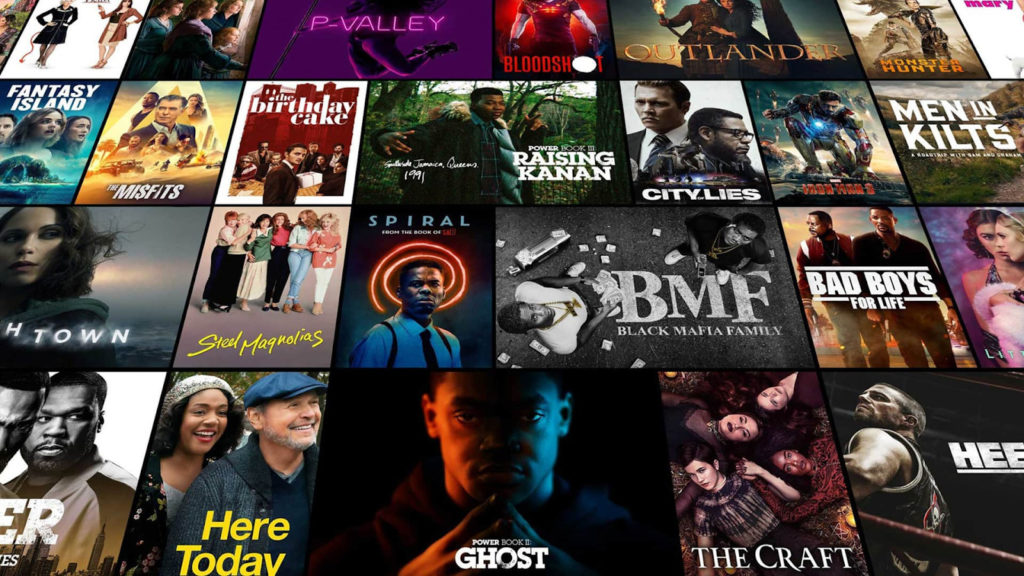

Starz was originally a television network, but the content available from the network is now available on a dedicated OTT service. Users can log into Starz with the credentials to their account with their television providers.
Revenue:
Starz’s total revenue for fiscal year 2024 was approximately $1.502 billion, with a total segment profit of about $183.2 million.
Pricing:
Users without a television or cable subscription can get an online subscription for:
- Monthly plan: $10.99 per month
- Semi-annual plan: $45.99 for six months
- Starz + BritBox bundle: $14.99 per month
- Vizio Starz-AMC+ combo: $13.99 per month
10. Peacock
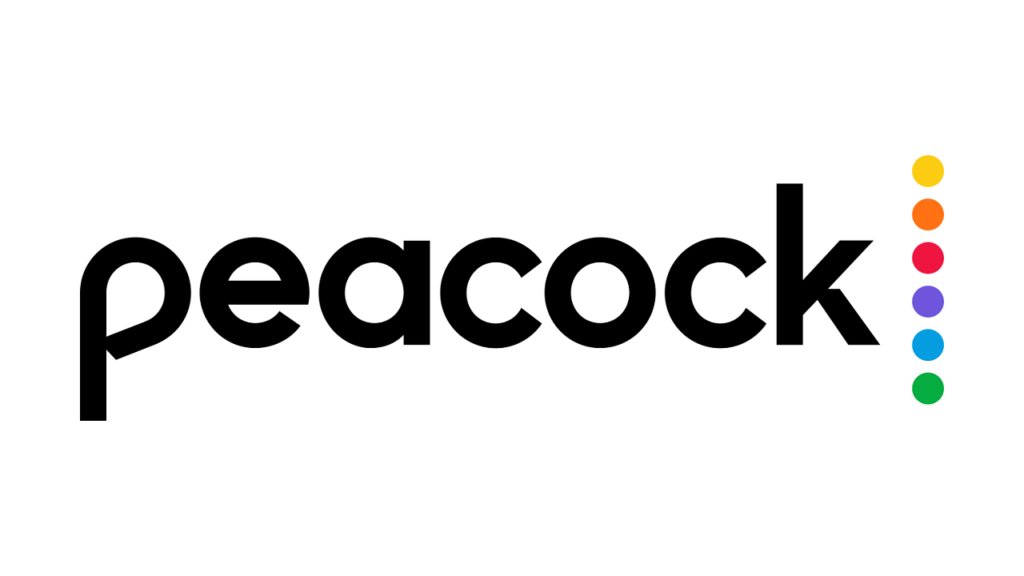

Peacock, a rising star among newer OTT streaming services, is owned by NBCUniversal, which is a subsidiary of Comcast. Peacock features many different types of movies and television series, including titles owned by NBC and some Peacock originals.
Revenue:
In the first three quarters of 2024, Peacock, NBCUniversal’s streaming service, generated approximately $3.6 billion in revenue, surpassing its total 2023 revenue of $3.3 billion.
Pricing:
Users can start streaming on Peacock for a free trial. Pricing plans include:
- Upgrading to Peacock Premium for $7.99 per month or $79.99 per year opens access to a larger content library.
- Premium Plus at $13.99 per month or $139.99 per year gives access to the same content library, more live content, ability to download it, and ad-free streaming.
What is an OTT Platform?
Over-the-top (OTT) broadcasting is revolutionizing the way content is delivered, making traditional cable and satellite providers increasingly obsolete. Instead of relying on intermediaries, OTT platforms allow broadcasters to stream content directly to viewers over the internet, offering greater accessibility, flexibility, and control. This shift has fundamentally changed how audiences consume media, enabling them to watch their favorite shows, movies, and live events on-demand, anytime, and on any smart device.
For content creators, businesses, and media companies looking to distribute video content, having the right OTT platform is essential. These platforms provide the infrastructure needed to host, manage, and deliver high-quality streaming experiences. They support a variety of monetization models—such as subscription-based (SVOD), ad-supported (AVOD), and transactional (TVOD)—allowing broadcasters to tailor their revenue strategies.
Moreover, OTT platforms empower broadcasters with tools for audience engagement, content personalization, and analytics-driven insights. With advanced features like adaptive bitrate streaming, content recommendation algorithms, and multi-device compatibility, OTT platforms ensure seamless viewing experiences for users while maximizing reach and revenue potential for content owners.
As consumer demand for on-demand, personalized content continues to rise, OTT platforms have become a critical component of the modern streaming industry. Whether for entertainment, sports, e-learning, or corporate communications, these platforms provide the backbone for delivering rich, interactive, and engaging video content without the restrictions of traditional TV broadcasting.
Why do Businesses Launch Their Own OTT Platforms?
The reasons businesses choose to launch their own on-demand content platforms may be numerous, but here are the main ones:
- Monetization: Through subscription-based streaming options, pay-per-view, or ad-based OTT monetization models
- Targeted marketing campaigns: Data-driven insights help optimize marketing strategies
- Branding: A customized platform strengthens brand identity
- User experience: Offering a seamless, user-friendly streaming app helps increase viewer engagement
- Tailored content: Delivering content based on user preferences enhances loyalty
OTT Aggregators and Attribution
An OTT aggregator will consolidate multiple top streaming platforms 2025 under one service, simplifying user content access and increasing their OTT service user experience. For example, an OTT aggregator might offer content from live streaming services, on-demand content platforms, and family-friendly OTT platforms, all in one place.
Aggregators simplify the user experience, providing a broader range of content and easy navigation across platforms. This creates an opportunity for broadcasters to reach a wider audience and increase visibility on multiple platforms.
An OTT attribution allows broadcasters to measure user engagement and track performance across OTT channels. This helps broadcasters optimize content offerings, refine marketing campaigns, and ultimately improve ROI, making it a key part of choosing the right OTT platform and providing your viewers with the best video streaming services.
How to Choose an OTT Platform
Creating popular streaming apps that will attract the desired audience requires careful planning. Premium video services have to offer the highest streaming quality and performance. Here are some monetization options that should be considered:
- Subscription-based streaming options
- Pay-per-view options in streaming
- Ad-supported services
- Hybrid models
Broadcasters should also compare OTT service features with competitors and improve them, including:
- Multi-device streaming options
- User-friendly apps
- Content availability on OTT platforms
- Live streaming (broadcasting) features
- VOD hosting capabilities
- Video API
- Reliable security tools
- White-label streaming
- International streaming services via a Video CDN
Businesses whose goal is to live stream should select an OTT video hosting platform that supports live streaming.
Another feature broadcasters use is a Video API for programmatic access to video platform functionality so they can customize their video content management system (CMS) to your liking.
And you should also consider live streaming pricing. Your budget should be determined by your available resources and your expected return on investment. You will find that the top streaming platforms in 2025 come with a wide range of price points. However, you want to look for one with consistent pricing and low bandwidth costs instead of a pay-as-you-go model.
OTT Platform As a Service
Many content creators, broadcasters, and businesses are realizing the power of having a direct line to their audience. However, creating your own OTT platform from scratch takes a lot of time and resources. It also requires your team to have specialized skills like coding, so most businesses turn to companies that offer building an OTT platform as a service.
These providers give you the platform and tools you need to broadcast and stream your content directly to audiences using the Internet, bypassing traditional cable or satellite providers. They can easily scale up to accommodate growing viewership and increased demand for content.
Comparison of the 20 Best OTT Platforms for 2025
Before we look at some of the top OTT platforms and streaming services available to professional broadcasters, it is important to note that different features are required to reach different broadcasting goals
For example, monetization tools are a must if you are building a live streaming software service to generate revenue. However, monetization tools aren’t a deal-breaker if you’re using your OTT platform to host and deliver internal content.
With that in mind, let’s look at the top 10 OTT Platforms in the world for video streaming.
1. Dacast
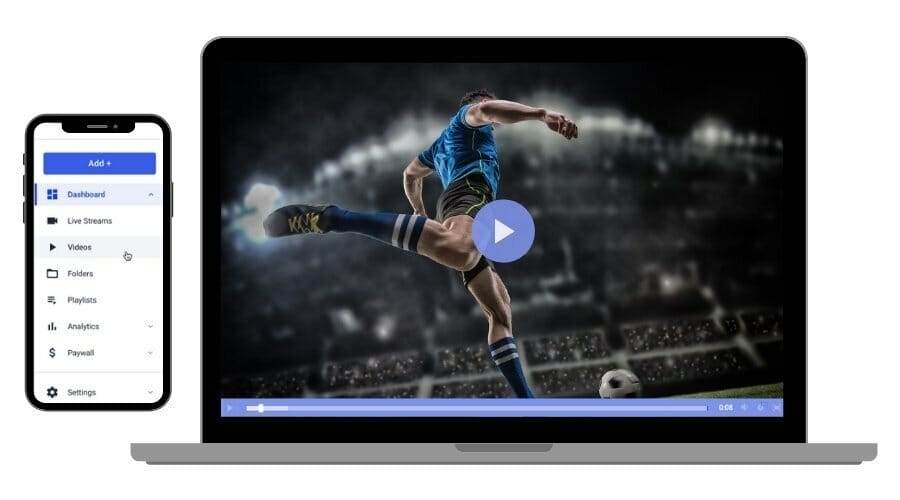

Dacast is a unified streaming platform for broadcasters that offers VOD and live streaming services. It has a wide spread of powerful, full OTT content and technology features that are well-suited for professional broadcasters. This platform is password protected and easy to use to distribute video content to viewers around the world securely.
Key Features
- Monetization tools (SVOD, AVOD), and pay-per-view (TVOD)
- White label and branding control
- Adaptive bitrate streaming to allow multiple streams with varying bitrates
- RTMP Encoder for ingesting HLS streaming
- Low latency HTML5 channels for video streaming
- Live encoding support for the top video encoders
- Zoom live streaming integration
- Expo galleries video portal
- Unlimited viewers and live channels
- Video security tools for secure streaming
- Global content delivery with strategic CDN partnerships
- Multi-bitrate streaming
- Player API and Video API access
- 24/7 tech support
New!
- M3U8 file creation capability to enable adaptive streaming delivery of OTT video content across various devices
- Multistreaming capabilities for simulcasting to multiple platforms at once
- Fully integrated RTMP streaming platform features
- AES encryption for secure video streaming
- Multi-user access on Scale and Custom plans
- Zoom live streaming integration for meetings and live events in real-time
- Expo 2.0 galleries video portal for immersive video experiences
Pros
- VOD and live stream video hosting
- Real-time analytics
- Ad-free streaming
- Wide range of privacy and security tools
- Mobile device support
- Live stream recording
- China Video Hosting
- Plans for every budget
Cons
- A large range of features require a bit of an initial learning curve
Upload Guidelines and Specs
- Minimum dimension: None (but 240p is the recommended minimum)
- Maximum dimension: 1080p or 4K (depends on the user’s hardware and internet)
- Video aspect ratio: No restrictions (but 16:9 is the default)
- Max file size: None
- Max video length: None
- Total file storage: 10-1000GB (depends on plan)
- Compatible video formats: MP4 (preferred), MOV, M4V, M2V, AVI, MPG, FLV, WMV, MKV, WEBM, OGV, MXF, ASF, VOB, MTS
Pricing
Dacast’s live streaming pricing plans begin with the Starter Plan, and include the following:
- Starter plan – $39/month: Ideal for newcomers with 2.4 TB of bandwidth and 500GB of storage per month, billed annually at just $39 per month.
- Event plan – $63/month: For organizations who’d rather not sign a contract and want to purchase bandwidth separately. It offers 6 TB of bandwidth upfront, 250 GB of storage, and costs just $63 per month (or $750/year). Additional data and storage can be added as needed.
- Scale plan – $165/month: Includes 24 TB of bandwidth per year, with 2000 GB of storage for $165 per month billed annually. These Scale pricing plans add phone support, a monetization paywall, an M3U8 link tool for live channels, ad insertion, white-label Cnames, and video API access.
However, Event and Scale users can also purchase custom plans for greater bandwidth needs. Dacast is one of the leading OTT live streaming media services platforms globally.
2. IBM Cloud Video


IBM Cloud Video is another competitor worth mentioning in our best OTT platforms comparison. This broadcasting platform is part of IBM, which is a leader in the technological world. IBM Cloud Video offers video hosting for both live and on-demand content.
One previous setback of IBM Cloud Video was that the OTT broadcasting platform did not offer monetization options. However, they have recently added these tools, making it an acceptable solution for broadcasters who aim to generate revenue with their content.
The ability to support 4K video streaming also makes it a great platform if you want to deliver a great user experience.
Key Features
- Powerful video analytics
- Tools for boosting user engagement (including polling)
- Auto-archiving
- Powerful content delivery
- Tools for video monetization
Pros
- Tools suited for business use
- Customer support
- Hong Kong video hosting
Cons
- Extra fees for streaming at high resolution
- Limited tools for accessibility (minimal closed captioning support)
Upload Guidelines and Specs
- Minimum dimension: 480p (480 x 270)
- Maximum dimension: 4K (3840 x 2160)
- Aspect ratio: No published aspect ratio
- Max file size: 4 GB
- Max video length: No published limits
- Total file storage: 1TB – 5TB (depends on plan)
- Compatible video formats: MKV, MP4, MOV, FLV, AVI, WMV, MPEG2, H264, H263, MPEG4, VP6, VP8, THEORA, WMV, MP3, AAC-LC, NELLYMOSER, PCM, SPEEX, VORBIS, WMA
Pricing
IBM pricing plans range from $137 to $1380 per month and include the following:
- Start Trial – Video Streaming: Give it a free test drive for 30 days
- Silver: Affordable Essentials, 100 viewer hours, 5 channels, 1 TB video storage, starting at $145/month
- Gold: Standard business features, 2,000 viewer hours, 10 channels, 2 TB video storage, starting at $729/month
- Platinum: Premium Volume scale, 5,000 viewer hours, 20 channels, 5 TB video storage, starting at $1,460/month
- Custom: Please contact IBM Cloud video for custom plan pricing as well as payment plans
3. Wowza


We’re including Wowza because it’s a fully capable OTT platform geared toward professional broadcasting. Wowza allows broadcasters to build highly customized streaming workflows using third-party integrations, APIs, and other advanced OTT features.
It offers 4K streaming, live stream recording, and video on demand. Still, its major downfall is that it does not support video monetization, which makes it less popular with professional streamers and broadcasters. It also lacks multi-camera feeds and audience analytics. Use it to market your products through live-streaming product launches, interactive sessions between customers and your team, and more.
Key Features
- Cloud transcoding
- Support for live streaming and VOD
- White-label video player
- All-device streaming with an HTML5 video player
- API access available
- Reliable customer support
Pros
- Brand customization tools
- Auto-archiving
- Powerful video CMS
- Ultra HD streaming (4K)
- Wide range of security options
Cons
- No simulcasting tools
- No support for video monetization
- No reliable video analytics tools
Upload Guidelines and Specs
- Minimum dimension: 240p (320 x 240)
- Maximum dimension: 4K (3840 x 2160)
- Aspect ratio: 16:9, 4:3
- Max file size: Not available
- Max video length: Not available
- Total file storage: 250 GB (depends on the plan)
- Compatible video formats: MP4, FLV, MP3, SMIL, AMLST, ID3, NGRP
Pricing
Wowza offers two main tiers: Streaming Cloud and Streaming Engine.
The Wowza Streaming Cloud offers four distinct pricing plans and services. Live Event Pricing, monthly plans include:
- Pay As You Go: $0 per month only pay for usage at a rate of $2.50 per streaming hour and $0.10 per viewer hour
- One Month of Streaming: $149 one-time purchase; includes 15 hours of live streaming and 500 viewing hours
- Plans built for your needs: Best for large audiences and large volume videos, but you should contact Wowza for custom pricing
All the Live Event plans reflect rates when paid monthly and include full brand control, multi-bitrate streaming, and UHD and HD streaming.
The Wowza Streaming Engine has its own professional-grade streaming plans billed annually and includes:
- Basic Monthly: $195/month with the first instance included (Additional instances $195)
- One Month Streaming: $295/month with the first instance included (Additional instances $295)
Enterprise Plans built for your needs: Best for large audiences and large volumes, but you should contact Wowza for custom pricing
4. JW Player


JW Player is most well-known for its popular video player. The code for this video player was used as part of the first YouTube video player code. However, they recently launched a live streaming service as well. JW Player includes a full suite of powerful tools, including an HTML5 video player that supports the latest technologies such as the MPEG-DASH protocol, multi-bitrate streaming, simulcast to Facebook Live, DRM, and more.
Additionally, JW Player provides complete customization on its plans and gives a 30-day free trial so you can get a feel of it before choosing it as your top online broadcasting platform.
Key Features
- Global content delivery
- Video API access with all plans
- Ad-based monetization
- Multi-bitrate and adaptive streaming
- Some technical support is available
Pros
- High-quality video player
- Clean user-interface
Cons
- Limited monetization options (Only supports AVOD)
- Limited tech support
- No China delivery
Upload Guidelines and Specs
- Minimum dimension: 360p (640 x 360)
- Maximum dimension: 1080p (1920 x 1080)
- Aspect ratio: 16:9, 4:3, 2.39:1
- Max file size: 25GB
- Max video length: Not available
- Total file storage: 25GB to 500GB (depending on the plan)
- Compatible video formats: MP4, WMV, AVI, MOV, 3GP, FLV
Pricing
JW Player offers four custom pricing plans, but you’ll need to get in touch with their team to check for the pricing details. You can choose between the following plans:
- Stream: This plan offers video delivery, asset management, instant and broadcast live
- Play: This plan offers cloud hosting, HTML5 Player, OTT apps, and mobile SDKs
- Engage: Take advantage of real-time analytics, recommendations, article matching, and custom reports
- Monetize: Use tools like ad insertion, player bidding, outstream ads, and studio DRM
5. Brightcove
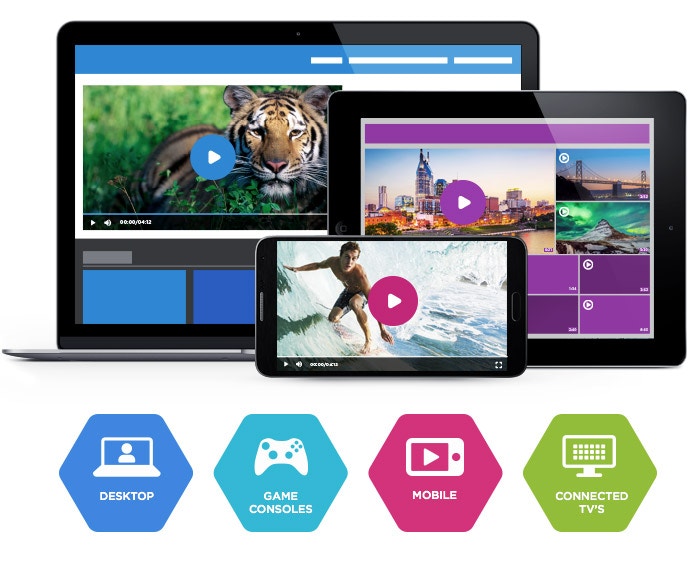

Brightcove is another trusted solution in the OTT video platform. Its cloud video hosting suite is equipped with everything broadcasters need to succeed over the top and in online video hosting. Brightcove is primarily geared towards business video hosting use, but you can build custom packages to include all of the tools broadcasters need to create a streaming media platform.
Key Features
- Access to top-tier CDNs for global content delivery
- Multi-bitrate and adaptive bitrate streaming
- Video API access
- Basic tech support
- Advanced security features
- Monetization tools
Pros
- Custom video player landing pages
- CRM integration available
- Wide range of professional broadcasting features
Cons
- High pricing
- No China video delivery
Upload Guidelines and Specs
- Minimum dimension: Determined by user
- Maximum dimension: Determined by user
- Aspect ratio: No restrictions (since Brightcove uses a responsive player)
- Max file size: No limits on files size
- Max video length: No published limits
- Total file storage: Varies by plan
- Compatible video formats: MP4, MOV, FLV, AVI, WMV, MKV, 3GPP
Pricing
Brightcove builds custom pricing plans to suit enterprise streaming needs. Please contact their sales department to find out the pricing structure for their live streaming features.
Here is what we currently know about their pricing structure:
- Basic Plan: Starts at $99 per user per month, which includes core video hosting and management functionalities. This plan is well-suited for businesses with basic video needs, such as small content libraries or internal communications.
- Enterprise-Level Plans: These plans are highly customizable and include advanced features such as live streaming, in-depth analytics, security options, and robust integrations. Pricing is tailored depending on the specific needs of the business, including audience size, storage requirements, and additional services like video monetization and support.
- Customization Costs: Enterprises may face additional expenses for features like platform customization, data migration, employee training, and ongoing maintenance. These costs can range from a few thousand dollars to significantly more, depending on the complexity of the requirements.
- Free Trial: Brightcove offers a free trial for prospective users to test its features before committing to a subscription, which is a helpful option for evaluating its capabilities in real-world scenarios.
6. Contus Tech


Contus Tech is a cloud-based video streaming platform that offers scalable and customizable solutions for video-on-demand and live streaming. It’s one of the popular streaming apps that has a diverse clientele that is well-distributed. It’s designed for businesses looking for an OTT platform as a service. It allows them to create a white-label video streaming platform, allowing full control over video management, monetization, and distribution. It supports various industries like entertainment, education, media, and enterprise communication.
Key Features
- Live and on-demand streaming
- Supports various monetization models
- End-to-end OTT services
- Fully customizable white-labeling for custom branding
- Advanced analytics to track performance and user engagement
- Compatibility with a wide range of video formats and devices
Pros
- Highly customizable and scalable, fitting businesses of all sizes
- Comprehensive monetization tools that support multiple revenue models
- Strong security features to protect content
- Allowing businesses full control over branding and design
Cons
- Not transparent about pricing
- Steep learning curve due to complex setup
Upload Guidelines and Specs
- Minimum Dimension: 480p and higher for quality streams
- Maximum Dimension: up to 4K Ultra HD
- Aspect Ratio: 16:9, 4:3
- Max File Size: Depends on the plan and storage allocation
- Max Video Length: Unlimited, subject to storage and bandwidth constraints
- Total File Storage: Scalable cloud storage options to accommodate large video libraries
- Compatible Video Formats: MP4, MOV, AVI
Pricing
To learn more about the pricing they charge for OTT platform development, you’ll need to contact the Contus Tech sales team. Since they have no information on their website about pricing plans, this is the only way to learn how much it will cost you.
Many clients like this flexible hiring model and pay-as-you-go model. You can hire developers for the duration of your specific project, decreasing the development costs. This also means you only pay for what you actually use.
7. Kaltura
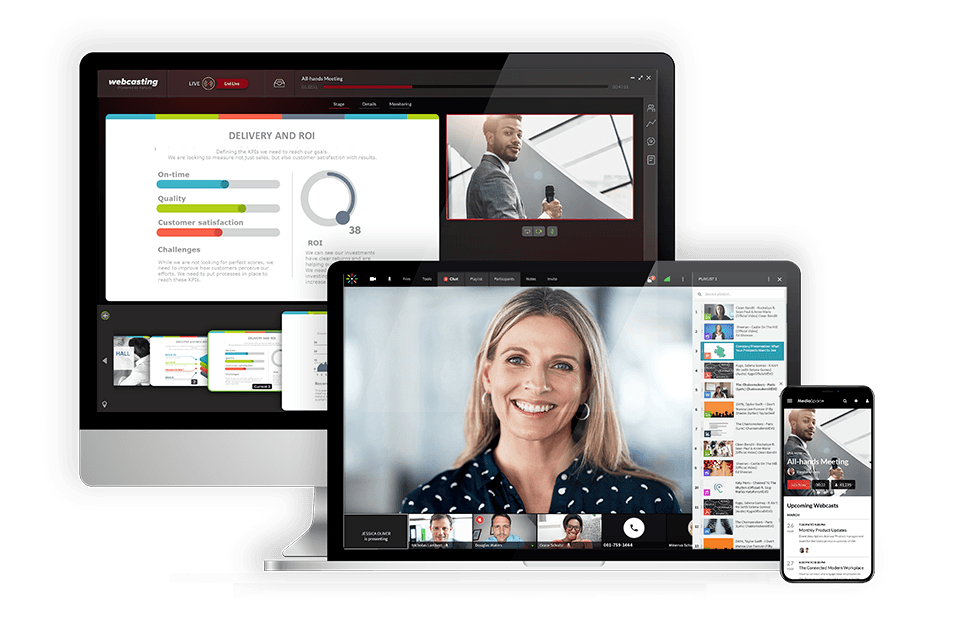

Kaltura is open-source software that offers a unique OTT streaming technology platform that focuses on educational institutions. It is perfect for hosting large content libraries and delivering it with a branded video player. What makes Kaltura’s OTT service unique is that it is customizable thanks to various integrations. Kaltura also provides cloud-based hosting and streaming services as a base for these customizations. With its open-source foundation, Kaltura is highly customizable and extensible. Companies can build their own integrations and add-ons to meet specific needs.
That said, while Kaltura is a top online broadcasting platform, it falls behind in terms of user friendliness. It’s slightly complicated to use and has a long learning curve, making it inaccessible to beginners.
Key Features
- Developer tools: Development teams use Kaltura’s video cloud APIs and developer tools, which allow active media asset management.
- Video content management system: Kaltura offers a single place for you to manage all of your videos, with tools for:
- Ingesting video
- Managing video
- Publishing videos
- Analyzing data from videos
- Interactive video tools: Since Kaltura targets the educational market, it offers many interactive video tools. This includes digital whiteboards, shared notes, chat tools, and more to create an interactive live video experience.
- Live and VOD hosting: Kaltura offers both live and VOD hosting, so you can host all your videos in one place.
- Quality video playback: Kaltura offers quality video feedback with both multi-bitrate and adaptive streaming.
Pros
- Completely customizable
- Very few limits on features thanks to integrations
- Well-suited for advanced broadcasters
Cons
- The “pay-as-you-go” structure often makes it more expensive to use
- Complicated platform
- Not cut out for beginner broadcasters
- Slow-to-respond tech support
Upload Guidelines and Specs
- Minimum dimension: 180p (320 x 180)
- Maximum dimension: 1080p (1920 x 1080)
- Aspect ratio: 16:9, 4:3
- Max file size: 2GB
- Max video length: Not available
- Total file storage: 10GB to Unlimited (depends on the plan)
- Compatible video formats: MOV, MP4
Pricing
Prices are based on the solutions you’re looking for. These billed monthly plans include:
- Business: $199/month (or $150/month when billed annually)
- Enterprise: Custom pricing
- Free trial: 14 days; up to 25 participants per session
- Basic: $19/month (or $17/month when billed annually); up to 8 participants per session and 8 hrs of cloud recording
- Pro: $55/month (or $50/month when billed annually); up to 25 participants per session and 15 hrs of cloud recording
- Business: $125/month (or $115/month when billed annually); up to 100 participants per session and up to 25 hrs of cloud recording
- Business Plus: Custom pricing for up to 300 participants per session, unlimited sessions and custom storage needs
- Annual discounts: Discounted pricing packages available for any scale and use-case, enterprise SLA, and developer support
- Limited trial account: $1 for $100 worth of credits for 30 days for testing and experimentation, with no commitments
- Pay as you go – You pay only for what you use at these credit levels:
- Base plan: $20 one-time annual fee + monthly usage fees
Other services include virtual events, video portal town halls, video messaging, meetings, and more.
8. Restream
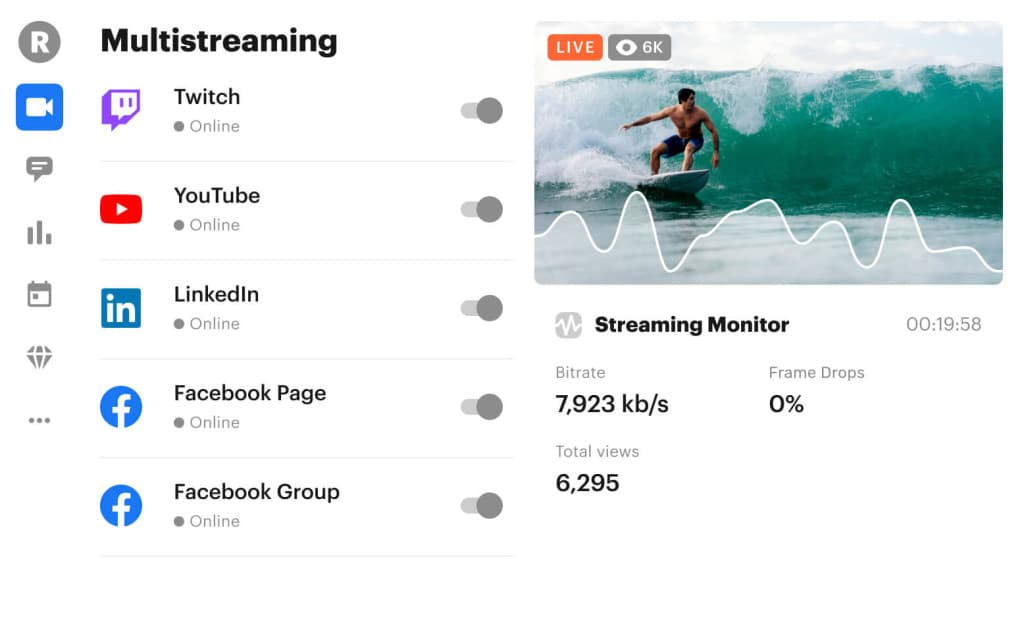

Restream is a streaming platform specializing in multistreaming but offering other streaming products. It’s designed to support both beginner streamers and advanced users, offering a variety of tools for managing live streams, such as chat management, scheduling, and in-depth analytics.
Restream Studio is their offering that supports in-browser live streaming. Sports fans like its live sports streaming options, but it is also quite popular among the gaming, tech, government, media, and music industries. Other than the ability to broadcast video in real-time, it’s also designed to increase brand exposure and sales.
Key Features
- In-browser streaming
- Multistreaming capabilities
- Features for boosting engagement
- Peer-to-peer streaming support
- Tools for audience interaction
- Brand customization
- Scheduled events
Pros
- Easy to use
- Tools for collaboration
- On-brand streaming
- Tools for audience engagement
Cons
- Not a dedicated streaming platform
- In-browser streaming is secondary to live-stream hosting
Upload Guidelines and Specs
- Recommended dimension: 1920 ×1080
- Aspect ratio: Unavailable
- Max file size: 2GB (for pre-recorded streams)
- Max video length: 1-4 hours (depends on plan)
- Total file storage: 10 videos
- Compatible video formats: MP4, MKV, M4V, MOV
Pricing
Restream has several pricing plans for both individuals and businesses. These include the following plans:
- Free: $0/month (for individuals) with 2-channel multistreaming
- Standard: $16/month (for individuals) with 3-channel multistreaming
- Professional: $39/month (for individuals) with 5-channel multistreaming
- Business: $199/month (for businesses) with 8-channel multistreaming
- Enterprise: Custom pricing and solutions for media and corporate teams
These prices reflect monthly rates when paid monthly, but discounts are available when you pay a full year in advance.
9. Vidyard


Vidyard is a top OTT platform for businesses that provides users with many unique tools and features. This video streaming platform is geared towards marketing and sales since its features are designed to turn viewers into customers. The Vidyard platform includes tools to improve audience reach and viewer engagement so broadcasters can use it to generate qualified leads.
But the biggest drawback of Vidyard is that you can’t reach China audiences for your online streams. Instead, broadcasters would have to opt for other Chinese streaming platforms that have servers in China.
Key Features
- Marketing tools (SEO, lead generation, email capture)
- Tools that promote viewer engagement
- Advanced video content management
- Gold-standard security
Pros
- Tools for an advanced broadcasting experience
- Powerful video analytics
- Reliable technical support
Cons
- Inconsistent positive user reviews
- No support for China video delivery
Upload Guidelines and Specs
- Minimum dimension: 360p (480 x 360)
- Maximum dimension: 4K (3840 x 2160)
- Aspect ratio: 16:9, 4:3
- Max file size: 5GB to 16GB (depending on the plan)
- Max video length: 1 hour (live stream)
- Total file storage: Not available
- Compatible video formats: WEBM, MP4, MKV, MOV
Pricing
Vidyard prices its platform based on the use case and includes the following packages:
Packages for Individuals and Teams:
- Free: Video sharing; video editing; video sharing; stock AI avatars
- Starter: $59/month; team performance analytics, password-protected videos, and customizable branding
- Teams: $99/month; everything in Starter + CRM/MAP integrations for seamless workflows, folder management, video captions, and advanced analytics
- Enterprise: Custom pricing; AI avatars, SSO user management and secure playback, unlimited integrations, custom permissions and security options
Check out Vidyard’s pricing plans for more information.
10. Vimeo OTT
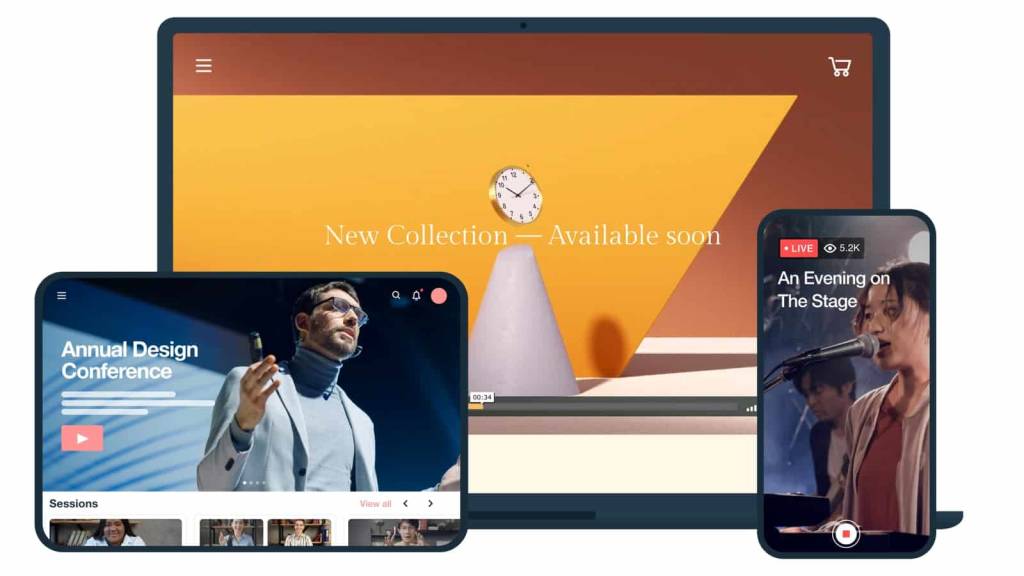

After many years as a streaming service, Livestream was acquired by Vimeo in late 2017. Today, both businesses operate OTT video streaming services under Vimeo’s name. Vimeo has integrated an OTT solution into its services. Let’s take a closer look at Vimeo’s OTT services.
Key Features
- Simulcasting and multistreaming support
- Viewer engagement tools (polling and chat options)
- Powerful security tools
- Custom video gallery pages
- In-house content delivery
- White-label video player
Pros
- Global content delivery
- Customization for on-brand streaming
- Tools for promoting interaction and engagement
Cons
- Support required to access some features
Upload Guidelines and Specs
- Recommended dimension: 720p (1280 x 720)
- Aspect ratio: 16:9, 4:3
- Max file size: 3GB
- Max video length: Information not available
- Total file storage: Information not available
- Compatible video formats: MP4 (recommended)
Pricing
Vimeo Livestream offers its OTT product on a completely separate payment structure:
1) Vimeo OTT:
Vimeo’s OTT solution is priced separately from the regular Vimeo packages. There are two plans: Starter and Enterprise.
- Starter Pricing: $1/subscriber per month
- Enterprise Pricing: Please contact Vimeo for custom pricing information
Vimeo also diversifies its offering with video hosting plans that are suitable for content creators and startups.
Pricing if billed monthly, is as follows:
- Free: $0/month; 1 GB storage, creation and editing, screen recording
- Starter: $20/month; 100 GB storage, auto closed captioning, custom URLs and video player, privacy tools
- Standard: $41/month; 1 TB storage, engagement and social analytics, AI script generator, teleprompter, brand kit
- Advanced: $108/month; 5 TB storage, stream to multiple destinations, host live broadcasts and webinars, AI-generated chapters and text summaries
- Enterprise: Custom pricing; more storage and bandwidth, advanced AI capabilities, quality events, dedicated support
All plans are billed annually.
11. Gudsho


Small and medium content creators and video business owners will find Gudsho to be an excellent OTT platform for them. They can use it to host, market, and monetize their video content across numerous platforms and devices. It has an open video content library, much like that of YouTube, covering numerous genres that are of interest to a wider audience. You can also take advantage of the liberal video monetization policy and make some money from the videos that you share.
Key Features
- Allows import of large video content at once
- Built-in video analytics to enhance video performance
- A variety of monetization options
- Synchronize content distribution with the video scheduling feature
- Excellent 4K video streaming
Pros
- Wide audience reach
- An extensive range of content monetization options
- High-quality streaming across devices
- Embedding videos on other platforms to grow viewership
Cons
- Limited customization options
- Users report some software glitches
Upload Guidelines and Specs
- Minimum Dimension: 240p (426×240)
- Maximum Dimension: 4K (3840×2160)
- Aspect Ratio: 16:9
- Total File Storage: Unlimited
- Compatible Formats: MP4, Mkv, AVI, FLV
Pricing
Four pricing plans are available that are designed to fit into the budget and needs of every content creator:
- Free: Freely explore Gudsho with 5 hrs of video duration
- Stream: $19/month for persistent creators with 10 hrs of video duration included
- Stream Plus: $99/month for curious creators with 50 hrs of video duration included
- Stream Pro: $199/month for established creators with 300 hrs of video duration included
Pricing in a pay monthly basis. You can save 20% if you pay annually.
12. Hippo Video


As a video engagement platform, Hippo Video allows marketing and sales teams to connect via hyper-video and DIY in-video personalization. Teams can easily record, edit, and share marketing videos and implement custom workflows for email campaigns, marketing, sales, and customer support processes.
Using the CTA and lead generation forms, teams can generate more leads. Its hyper-video personalization allows customizing elements of thumbnails, CTAs, sales pages, etc. Hippo Video easily integrates with CRM, third-party sales, and marketing platforms.
Key Features
- Video creation and editing
- Screen recording and teleprompter
- Integrations
- Video personalization
- Hosting and sharing
Pros
- Intuitive and user-friendly interface
- Comprehensive video tools
- Seamless sales integration
- AI-driven tools
- Versatile use case
- Detailed analytics
Cons
- Not the most affordable option
- Limited advanced editing features
- Limited storage capacity
- Learning curve for some features
Upload Guidelines and Specs
- Minimum dimension: 480p
- Maximum dimension: 1080p
- Max file size: 3 GB
- Max video length: Depending on the chosen plan
- Total file storage: Limited, depending on the plan
Pricing
Hippo Video’s pricing structure offers a variety of solutions for different use cases. Here’s a breakdown of their pricing:
- Free: $0; includes 2 video flows, 10 minutes of closed captions, 5 videos – AI editor, 2 sales page templates
- Pro: $20/month; includes 5 video flows, 30 minutes of closed captions, 10 videos – AI editor, 5 sales page templates
- Teams: $60/month; includes 15+ video flows, 200 minutes of closed captions, 50 videos – AI editor, 15 sales page templates
- Enterprise: $80/month; includes unlimited video flows, unlimited minutes of closed captions, unlimited videos – AI editor, unlimited sales page templates
Text-to-Video is the second pricing category offered by Hippo Video that includes the following plans:
- Free: For $0 you get 3 video downloads, single-user workspace, AI trust and safety, and Pay-as-you-go ($5 for each video creation).
- Starter: $24/month/user. It’s designed for individuals creating videos and includes 10 video downloads, single-user workspace, AI trust and safety, and Pay-as-you-go ($5 for each video creation).
- Creator: For $69/month/user, individuals and teams scaling video content creation will get unlimited video downloads, multi-user workspace, and video translation.
- Enterprise: Users of this plan can produce studio-quality content with enterprise-grade security. Contact the Hippo sales team to get a customized plan and price.
Hippo Video also has special pricing plans for Personalization and Education. Users can contact Hippo Video directly for recorder API pricing.
13. Accedo


Accedo TV is among the many platforms that offer subscription-based streaming options. It allows media companies and operators to deliver next-generation content and video experiences directly to viewers. It is the maker of Accedo One, a platform that allows instant building of OTT user-friendly streaming apps.
You will find that the features of OTT platforms are similar, so content delivery capabilities and performance are also present here. Accedo’s features make it easier to scale and manage video streaming platforms across multiple devices and markets. It differs from other platforms because of its integration with Hoopla Digital, enabling access to extensive unlimited content collections.
Key Features
- Multi-device streaming options
- Video playback with analytics and reporting
- Customization user interface
- A comprehensive OTT content management system
- OTT app builder
Pros
- White-label platform
- Easy to scale video services across multiple platforms
- Flexible integrations and customizable user interfaces
- Support for live streaming, offline viewing, and monetization
- Advanced personalization and analytics features
Cons
- Complex setups may require technical expertise
- Rather high cost for smaller businesses or startups
Upload Guidelines and Specs
- Maximum Dimension: Supports up to 4K video resolutions
- Aspect Ratio: Commonly supports 16:9 but customizable based on the platform
- Max File Size: Typically depends on the platform being used
- Max Video Length: Not explicitly limited but can depend on user settings and subscription levels
- Total File Storage: Varies based on the user’s plan and service level
- Compatible Video Formats: MP4, HLS, and MPEG-DASH
Pricing
As an enterprise-grade OTT Platform, it has high-end pricing. The subscription costs for streaming that you can choose include the following:
- Starter: $3,000/month for 20,000 monthly active devices
- Growth: $5,000/month for 50,000 monthly active devices
- Enterprise: Contact the sales team for custom pricing
14. TwentyThree


As a comprehensive video marketing platform, TwentyThree allows businesses to manage, distribute, and analyze their video content across multiple channels. It gears towards enhancing audience engagement, brand awareness, and lead generation through video content. With integrations for social media and websites, TwentyThree is a powerful solution for businesses aiming to optimize their video marketing strategy.
Key Features
- Webinar Hosting: An intuitive tool for creating engaging webinars
- Interactive Video Tools: Customizable video actions for deeper audience engagement
- Advanced Analytics: Track viewer behavior, engagement rates, and conversions
- Live Streaming: Stream live events directly through the platform
- Lead Generation Tools: Collect leads through video forms and calls to action
- SEO Optimization: Optimized video landing pages for better search rankings
Pros
- Large collection of enterprise-grade streaming tools
- Scalable streaming plans
- Reliable customer support
- Interactive tools that increase viewer engagement
- Long time player in the streaming space
- Secure content delivery online
Cons
- Some issues with integrations
- Issues with the chat feature
- Requires a bit of a learning curve
Upload Guidelines and Specs
- Maximum Dimension: Supports up to 4K video
- Aspect Ratio: Standard 16:9
- Max File Size: Depends on the plan, with no specific limit noted for higher-tier packages
- Max Video Length: Unlimited video length for premium users
- Total File Storage: Scalable based on the plan
- Compatible Video Formats: MP4, MOV, and AVI
Pricing
TwentyThree splits its pricing plans into three main categories, with several plans under each of these categories. Here’s how they are broken down:
Video Library and Personal Video:
- Pro: €19/month/per user
- Enterprise: €39/month (minimum 50 users)
- Video Marketing Platform: €499/month
- Enterprise: 2,500/month/workspace
- Pro: €499/month
- Complete: €1,499/month
- Enterprise: €2500/month/workspace
You can also choose to use the TwentyThree Bundle, which includes the following:
- Growth: $2,499/month/workspace
- Enterprise: $7,500/month/workspace
15. Wistia
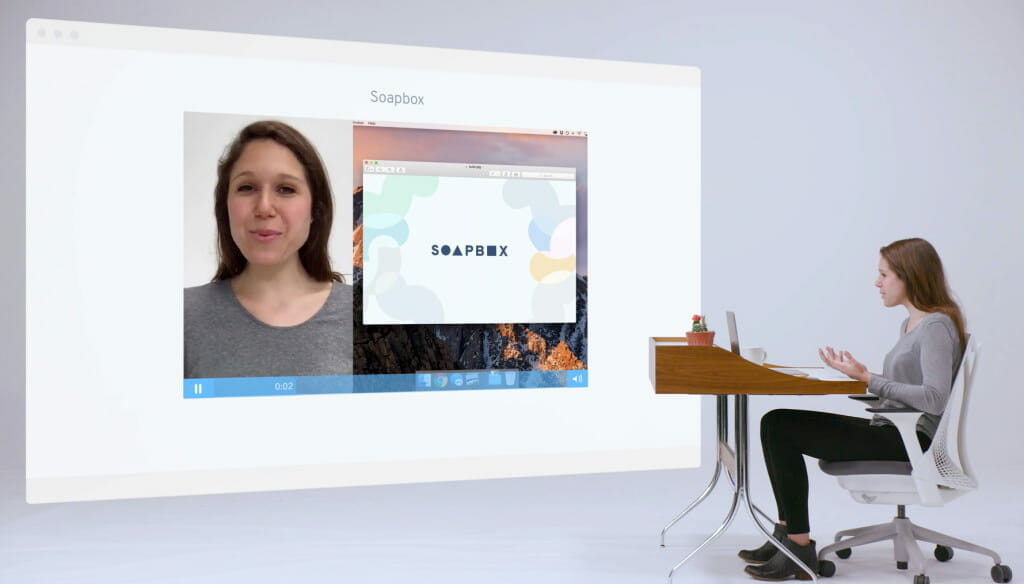

Wistia is a video hosting solution and excellent OTT platform for businesses serving the streaming video hosting and media distribution industry for over a decade. Students created it to primarily serve educational institutions and businesses.
Key Features
- Support for marketing (SEO and engagement stimulators)
- Top-tier customer service
- CRM integrations for a streamlined broadcasting experience
Pros
- Insightful video analytics
- Marketing team collaboration is possible thanks to CRM integrations
- Professional-looking video player
Cons
- Limitations on brand customization
- No China delivery
Upload Guidelines and Specs
- Minimum dimensions: None
- Maximum dimensions: Maximum of 4K (3840 x 2160)
- Supported aspect ratios: Any
- Maximum file size: 8 GB
- Maximum video length: 2 hours
- Total file storage: Up to 10 videos with the pro plan ($99 per month), $0.25 per month for every extra video
- Accepted video formats: MP4 (recommended format), .MOV, .AVI, .WMV, .FLV, .MKV, 3GPP
Pricing
Wistia has five pricing plan tiers, with a 20% discount when billed annually:
- Free: No cost to use; up to 250 subscribers and 3 videos; cannot remove Wistia’s branding from the video player; 15 minutes maximum webcam recording time
- Plus: $19/month; 30 minutes maximum webcam recording time; video SEO; option to remove Wisita branding; $2.00 for extra media costs
- Pro: $79/month; 60 minutes maximum webcam recording time; supports up to five channels; $1.00 for extra media costs; Google analytics integration; white-label video player
- Advanced: $319/month; supports unlimited number of channels; A/B testing features; live chat and priority support; $0.50 for extra media costs; 60 minutes screen and webcam recording time
- Enterprise: there are also business solutions with custom pricing; supports an unlimited number of users; 60 minutes screen and webcam recording time; $0.25 for extra media costs; custom pricing for live event additional costs
16. Muvi


As a comprehensive platform, Muvi makes it easy for businesses to launch their own branded video and audio streaming services. It caters to industries like entertainment, education, media, and enterprise. Centering on OTT media businesses, it offers end-to-end live and on-demand solutions.
Their OTT multi-screen video streaming solution helps businesses launch white-label multi-device streaming options.
Key Features
- Various monetization options
- HTML5 all-device video player
- Dashboard management CMS for naming and organizing content
- Support for video and audio streaming
- Various monetization options
- 24/7 support
- White-label platform
- Multi-device streaming options
Pros
- Comprehensive monetization options
- High scalability and reliability
- 24/7 customer support
- No coding required
- User-friendly interface
- Strong security features
Cons
- Advanced features come at a higher price
- Limited third-party integrations
- Steep learning curve for beginners
Upload Guidelines and Specs
- Minimum dimension: 144p (256 x 144)
- Maximum dimension: 4K (3840 x2160)
- Aspect ratio: 16:9, 4:3
- Max file size: not available
- Max video length: not available
- Total file storage: 1TB, 2TB, 5TB (depending on plan)
- Compatible video formats: MP4, MOV, MKV, FLV, VOB, M4V, AVI, 3GP, MPG
Pricing
Muvi has a very wide spectrum of pricing plans divided in 7 categories, namely One, Live, Flex, Player SDK, Playout, TV, and Alie.
1. The pricing for Muvi One includes the following plans:
- Standard: $399/month
- Professional: $1,499/month
- Enterprise: $3,900/month
- Ultimate: ask sales for price
Each plan has different features, such as the number of concurrent users, hosting options, and add-ons like the Alie recommendation engine. You can visit Muvi One Pricing for more details.
2. The pricing breakdown for the Muvi Live plans is as follows:
- Standard: $99/month
- Professional: $299/month
- Enterprise: $799/month
Each plan includes unlimited events and meetings, mobile live streaming, Ad-free high quality Streaming and custom branding and more. You can visit Muvi Live Pricing for more details.
3. Muvi Flex includes the following plans :
- Standard: $199/month
- Professional: $899/month
- Enterprise: $2,899/month
Each plan includes unlimited content and views, with varying features like the number of concurrent users, hosting options, and customization availability. Visit Muvi Flex Pricing for full details.
4. Here is the summary for the Muvi Player SDK pricing:
- Pay as You Go: $0/month + $0.001 per view (first 100 views are free)
- Enterprise: $499/month + $0.001 per view (first 100,000 views are free each month)
Visit the Muvi Player Pricing page for more detailed information.
5. Muvi Playout includes the following plans:
- Standard: $199/month
- Professional: $499/month
- Enterprise: $1,999/month
These plans differ in features such as the number of concurrent viewers, channels, and customization options. The Enterprise plan also offers dedicated servers. For more detailed features, visit the Muvi Playout Pricing page.
6. The pricing breakdown for Muvi TV is:
- Standard: $9/month + 9% commission on content sales.
This plan supports global distribution, and features include unlimited content, views, and the ability to publish and monetize quickly. For more details, visit the Muvi TV Pricing page.t
7. The pricing details for Muvi Alie is:
- Standard: $199/month
- Professional: $899/month
- Enterprise: $1,499/month
These plans differ in features such as ingestion features, training and recommendation requests. Visit the Muvi Alie Pricing page for more details.
17. Synamedia


Synamedia is a leading international platform for video delivery, protection, and monetization solutions. The purpose of this flexible and modular platform is to simplify the OTT management process.
Synamedia Go is part of the Synamedia family, offering several other modules for even more streaming solutions. This cloud-based SaaS platform fully integrates with Synamedia to ensure businesses have a comprehensive streaming experience.
Key Features
- Synamedia Go: A modular OTT platform for flexible and scalable content delivery
- Quortex PowerVu: Secure SaaS solution for managing global content distribution
- Fluid EdgeCDN: Optimizes content delivery with low latency and smart traffic management
- ContentArmor: Forensic watermarking for enhanced content security and anti-piracy
- Iris Advertising Platform: Targeted advertising for delivering relevant ads across multiple screens
Pros
- Highly scalable solutions for live and on-demand video streaming
- Advanced content protection features, including forensic watermarking
- Modular and flexible platform for OTT services, improving agility for broadcasters
- Strong focus on optimizing latency and bandwidth usage
Cons
- Pricing and complexity can be a concern for smaller businesses
- High-end features may require additional technical expertise for integration
Upload Guidelines and Specs
- Aspect ratio: Adaptable to various screen formats depending on the service (live, VOD, etc.)
- Max video length: Depends on the service (Synamedia Go supports live and long-form content)
- Total file storage: Dependent on cloud storage plans
- Compatible video formats: Includes standard broadcast formats like HEVC (H.265), MPEG-4, and others
Pricing
There is no information available on pricing on their website, meaning they most likely follow a custom pricing model. It’s best to contact their sales team to get information on the exact pricing.
18. Castr


Castr finds itself on our list as an OTT platform geared toward content creators looking to deliver high-quality video streams and zero-code. It’s used for hosting live events, streaming videos, and delivering high-quality content to a global audience.
This OTT platform offers users full customization freedom, white-labeling, and fantastic monetization options. It takes zero commission and supports full revenue retention.
Key Features
- Possibility to offer exclusive videos and premium content
- Customized, white-label OTT mobile app
- Monitor traffic and performance metrics in real-time
- Quick app development (develop within 24 hours and release on app store within a week)
Pros
- Ease of Use: The interface is user-friendly, and setting up streams is simple
- Flexible Multistreaming: Allows you to broadcast to multiple platforms simultaneously
- No Branding: Streams don’t display Castr’s branding, allowing for a fully customized experience
- 24/7 Support: In-house engineers are available to help around the clock
Cons
- Limited free trial to 7 days
- Advanced features are available only in higher-tier plans
Upload Guidelines and Specs
- Maximum Dimensions: 4096 x 2160 (4K)
- Aspect Ratio: 16:9
- Max File Size: Depending on the plan
- Max Video Length: Depending on the plan
- Total File Storage: Between 100 MB and 3 TB, depending on the plan
- Compatible Video Formats: Supports major formats, including MP4, MOV, FLV, and more.
Pricing
Castr has a wider selection of plans than its competitors, offering the following plans when billed monthly:
- Starter: $19.99/month with a free trial period
- Standard: $39.99/month
- Professional: $99.99/month
- Premium: $149.99/month
- Ultra: $299.99/month
19. Target Video


If you are a video advertiser or a digital publisher, then Target Video is your premium one-stop solution for video production, content management, and monetization. Based on user reviews of OTT platforms, it is a very customer-centric platform that offers transparency and ease of use. It is the place for specialized video distribution and monetization.
Key Features
- Possibility for bulk uploading, facilitating content management and distribution for publishers
- Track content performance and audience behavior with video analytic tools
- Closed captioning support for viewers with hearing impairments
- Improved brand visibility and recognition with brand overlays
Pros
- Supports various ad formats and offers competitive revenue sharing
- Easily handles high volumes of traffic, making it reliable for large publishers
- Integrates well with existing ecosystems, minimizing disruptions
- Tools to boost viewer retention and interaction
Cons
- Customization limitations may appear
- Not transparent about pricing
Upload Guidelines and Specs
- Maximum Dimensions: 4K
- Aspect Ratio: Standard aspect ratios such as 16:9 are recommended
- Max File Size: Not specifically mentioned
- Max Video Length: Varies based on the plan or publisher’s needs
- Total File Storage: Scalable storage depending on the publisher’s requirements
- Compatible Video Formats: Standard formats such as MP4 and MOV
Pricing
The Target Video website gives no information about pricing, so it’s best to contact their sales team for more information.
20. SproutVideo


SproutVideo is a Brooklyn-based business OTT platform equipped with top-tier marketing tools. It supports both the top five OTT content providers and business apps for live streaming and on-demand video hosting. This OTT service is designed primarily for business broadcasting.
Key Features
- Total API access
- White-label HTML5 video player
- Support for both VOD and live stream hosting
- A full suite of marketing tools
- Custom video portals for an on-brand viewing experience
Pros
- Wide range of pricing options
- Customizable video player
- Video analytics
Cons
- Premium support on expensive plans only
- Effective security only available with top-tier plans
Upload Guidelines and Specs
- Minimum dimension: None
- Maximum dimension: None
- Supported aspect ratios: Any
- Maximum file size: Up to 100 GB
- Maximum video length: Unlimited
- Total file storage: 500 GB
- Accepted video formats: MP4, MOV, AVI, WMV, FLV, MKV, 3GPP
Pricing
SproutVideo offers four pricing plans to target different budgets. They include:
- Seed: $10/month; 100 GB each of storage and bandwidth; best suited for broadcasters who don’t need many tools or functions
- Sprout: $35/month; 350 GB each of storage and bandwidth; comes with additional privacy tools
- Tree: $75/month; 1 TB each of storage and bandwidth; great for teams, offers advanced video site options
- Forest: $295/month; 2 TB each of storage and bandwidth; fully loaded with the features an advanced broadcaster would need
Why do Businesses Launch Their Own OTT Platforms?
The reasons businesses choose to launch their own on-demand content platforms may be numerous, but here are the main ones:
- Monetization: Through subscription-based streaming options, pay-per-view, or ad-based OTT monetization models
- Targeted marketing campaigns: Data-driven insights help optimize marketing strategies
- Branding: A customized platform strengthens brand identity
- User experience: Offering a seamless, user-friendly streaming app helps increase viewer engagement
- Tailored content: Delivering content based on user preferences enhances loyalty
OTT Aggregators and Attribution
An OTT aggregator will consolidate multiple top streaming platforms 2025 under one service, simplifying user content access and increasing their OTT service user experience. For example, an OTT aggregator might offer content from live streaming services, on-demand content platforms, and family-friendly OTT platforms, all in one place.
Aggregators simplify the user experience, providing a broader range of content and easy navigation across platforms. This creates an opportunity for broadcasters to reach a wider audience and increase visibility on multiple platforms.
An OTT attribution allows broadcasters to measure user engagement and track performance across OTT channels. This helps broadcasters optimize content offerings, refine marketing campaigns, and ultimately improve ROI, making it a key part of choosing the right OTT platform and providing your viewers with the best video streaming services.
How to Choose an OTT Platform
Creating popular streaming apps that will attract the desired audience requires careful planning. Premium video services have to offer the highest streaming quality and performance. Here are some monetization options that should be considered:
- Subscription-based streaming options
- Pay-per-view options in streaming
- Ad-supported services
- Hybrid models
Broadcasters should also compare OTT service features with competitors and improve them, including:
- Multi-device streaming options
- User-friendly apps
- Content availability on OTT platforms
- Live streaming (broadcasting) features
- VOD hosting capabilities
- Video API
- Reliable security tools
- White-label streaming
- International streaming services via a Video CDN
Businesses whose goal is to live stream should select an OTT video hosting platform that supports live streaming.
Another feature broadcasters use is a Video API for programmatic access to video platform functionality so they can customize their video content management system (CMS) to your liking.
And you should also consider live streaming pricing. Your budget should be determined by your available resources and your expected return on investment. You will find that the top streaming platforms in 2025 come with a wide range of price points. However, you want to look for one with consistent pricing and low bandwidth costs instead of a pay-as-you-go model.
OTT Platform As a Service
Many content creators, broadcasters, and businesses are realizing the power of having a direct line to their audience. However, creating your own OTT platform from scratch takes a lot of time and resources. It also requires your team to have specialized skills like coding, so most businesses turn to companies that offer building an OTT platform as a service.
These providers give you the platform and tools you need to broadcast and stream your content directly to audiences using the Internet, bypassing traditional cable or satellite providers. They can easily scale up to accommodate growing viewership and increased demand for content.
FAQs
1. What’s an OTT Platform?
OTT stands for over-the-top and refers to content providers that deliver streaming content to users via the internet to multiple devices like mobile phones, smart TVs, tablets, and laptops. OTT technology allows content to be delivered directly to viewers via the Internet, bypassing traditional mediums like cable, broadcast, and satellite TV. This approach removes the need for traditional media companies to control or distribute the content, giving consumers more direct access to streaming services.
2. Is Netflix an OTT provider?
Yes, Netflix is an OTT platform as it delivers content to its users over the internet. Its users don’t have to use other modes to access its content. Netflix is among the most popular OTT platforms in the world and has a user base of well over 247.2 million users.
3. What is OTT vs streaming?
OTT (over-the-top) streaming refers to delivering digital content straight to a user’s device via the internet, without relying on traditional broadcasting methods like cable or satellite. On the other hand, streaming in general is the broader concept of transmitting audio and video over the internet to users’ devices in real time. Both methods bypass physical media, but over-the-top specifically highlights content delivery without the need for traditional distribution channels.
4. What are the disadvantages of OTT platform?
OTT platforms come with several drawbacks. Users may experience buffering due to unstable internet connections and face security risks, including potential loss of personal data. Geographical restrictions and multiple subscriptions contribute to limited access and subscription fatigue. Content quality varies, and some platforms collect user data for marketing purposes, raising privacy concerns. Additionally, legacy platforms may struggle with newer technologies like 4K video and HDR, while the ease of access to OTT content can lead to addictive behaviors, especially among younger viewers.
5. What is the world’s largest OTT platform?
YouTube is the world’s largest OTT platform with over 2 billion monthly active users. But if you consider on-demand platforms that use the subscription model to generate revenue, Netflix is the biggest one with over 247.2 million users.
6. How do you create an OTT platform for your brand?
With the increased popularity of live streaming and video on demand, more businesses are looking to start their own OTT platforms. All that is needed is to define your OTT app development needs, create a budget, and define the UX/UI capabilities. You must ensure the video content is managed carefully by choosing the right technology stack.
7. What are the different ways to generate revenue from an OTT video platform?
OTT platforms make money depending on the different kinds of solutions. SVOD, SSAI, AVOD, transactional VOD, coupons, and promotions are just some of the most common monetization methods.
8. What are the most important features that make an efficient OTT platform?
The most crucial features of a successful OTT platform include secure monetization, multilayer analytics, sophisticated content management, pleasing user experience, integrated marketing tools, and superior streaming infrastructure.
9. How is OTT Delivered?
Original content on streaming services can be delivered on a variety of devices. This includes mobile OTT devices, personal computers, smart TVs, and gaming consoles.
10. What is an OTT IPTV player
An OTT IPTV player is a software application or device that allows users to stream live TV channels and on-demand video content over the internet using Internet Protocol Television (IPTV) technology. Unlike traditional cable or satellite services, OTT (Over-the-Top) IPTV players deliver content via the internet, bypassing conventional broadcasting methods and giving users greater flexibility in accessing media.
Conclusion
The subscription-based streaming options are already a daily habit for 3.9 billion OTT video users worldwide. In the United States, OTT viewership is expected to reach over 250 million in 2025, which is nearly 75% of the US population. For broadcasters who want to tap into this market, that means using only the best OTT platforms.
Given the size of this industry and the potential it holds, now is a great time to involve yourself in this trend. One of the first steps in getting started is choosing an OTT platform or video platform to host, manage, and monetize your streaming service.
The best way to choose an OTT platform provider is by taking advantage of free trials. That way, you can test out all the features and ensure that the platform is equipped with everything you need to reach your OTT streaming goals.
If you are still deciding between OTT platforms and want to try Dacast, we recommend signing up for our 14-day free trial. That way, you can test out all of our features before committing.
Lastly, did you find this article helpful, or do you have other comments or feedback? Let us know what you think via the chatbot below. We love to hear from our readers! For exclusive offers and regular live streaming tips, you can also join our LinkedIn group. Thanks for reading and, as always, good luck with your broadcasts!

 Connect
Connect
 Events
Events Business
Business Organizations
Organizations Entertainment and Media
Entertainment and Media API
API Tools
Tools Learning Center
Learning Center Support
Support Support Articles
Support Articles